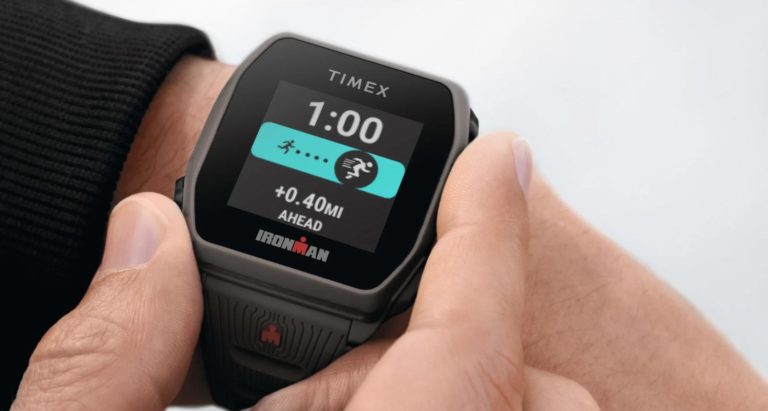Any links to online stores should be assumed to be affiliates. The company or PR agency provides all or most review samples. They have no control over my content, and I provide my honest opinion.
[Original Post: 19 October 2020] Now updated with benchmarks and more accurate information
The future of flagship chipsets from Huawei owned HiSilicon remains in doubt due to the extensive restrictions placed upon the company by the US in this protracted political dispute.
So the Kirin 9000 could very well be the swan song for Hisilicon, at least for flagship chipsets.
These issues have caused a delay for the Huawei Mate 40 series, but the phones will finally be launched globally this week, and as usual various leaks and benchmarks are quickly coming out prior to the launch.
This is technically more of a 2021 flagship chipset so it is the first one to launch. Therefore it is only possible to compare against Samsungs recently launched upper midrange Exynos 1080 and the existing Qualcomm Snapdragon 865+ (rather than the SD875 due to be announced in December).
Specification
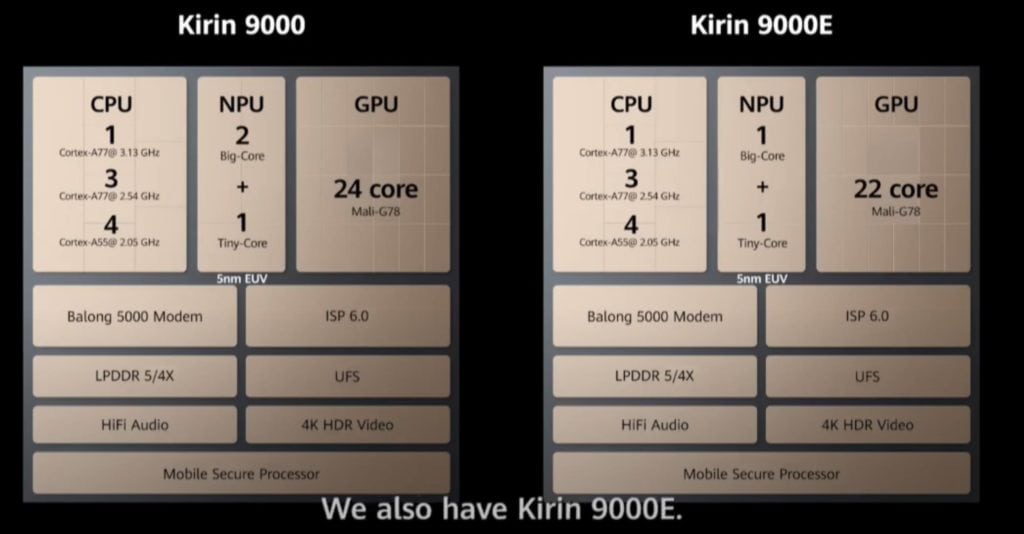
The exact specification of the Kirin 9000 remains unknown, but we know the chipset will be made on the 5nm fabrication process and leaked benchmarks indicate that the chipset is running four Cortex-A77 cores that are clocked at 3.13 GHz.
This would make it higher clocked than the existing Snapdragon 865+ which has its prime core running at 3.09 GHz. While this is a massive upgrade compared to the Kirin 990 5G it replaces, it is a generation behind what the SD875 will likely use.
The Samsung Exynos 1080 is the first chipset to implement the Arm Cortex A78, however, with this being a mid-range chipset it only has two of these cores, running at an unknown speed.
The Kirin 9000 will use the Arm Mali-G78 GPU and it has a massive 24 cores which should make it incredible for gaming
This is the same GPU as the Samsung Exynos 1080, which also has not had the cores or frequency specified yet.
| SoC | Kirin 9000 | Snapdragon 865+ | MediaTek Dimensity 1000 | Exynos 1080 |
|---|---|---|---|---|
| CPU | 1x Cortex A77 @ 3.13Ghz | 1x Cortex A77 @ 3.1GHz 1x512KB pL2 | 4x Cortex A77 @ 2.6GHz | 1 x ARM Cortex-A78 @ 2.8GHz |
| 3x Cortex A77 @ 2.54Ghz | 3x Cortex A77 @ 2.42GHz 3x256KB pL2 | 4x Cortex A55 @ 2.0GHz | 3 x ARM Cortex-A78 @ 2.6GHz | |
| 4x Cortex A55@ 2.05Ghz | 4x Cortex A55@ 1.80GHz 4x128KB pL2 4MB sL3 | 6 ARM Cortex-A55@1.8GHz | ||
| GPU | Mali-G78 24 Cores | Adreno 650 +10% Perf | Mali-G77MP9 @ ? MHz | ARM Mali-G78 MP10 |
| APU / NPU / AI Proc. / Neural IP | 2 big core, 1 tiny core | Hexagon 698 15 TOPS AI | "3rd gen APU" | Dual NPU + DSP |
| Memory | LPDDR5 / LPDDR 4X | 4x 16-bit CH @ 2133MHz LPDDR4X / 33.4GB/s or @ 2750MHz LPDDR5 / 44.0GB/s 3MB system level cache | ? | LPDDR5 @ 2750MHz |
| ISP/Camera | quad-core, 6th gen ISP | Dual 14-bit Spectra 480 ISP | 80MP | Single: 108MP |
| Integrated Modem | Balong 5000 4G + 5G NR NSA+SA Sub-6GHz | external X55 (5G NR Sub-6 + mmWave) DL = 7000 Mbps UL = 3000 Mbps | 5G Sub-6 DL = 4600Mbps UL = 2500Mbps | Exynos Modem External (5G NR Sub-6) DL = 5100 Mbps (5G NR mmWave) DL = 7350 Mbps |
| Process | TSMC 5nm | TSMC 7nm (N7P) | N7 | 5nm |
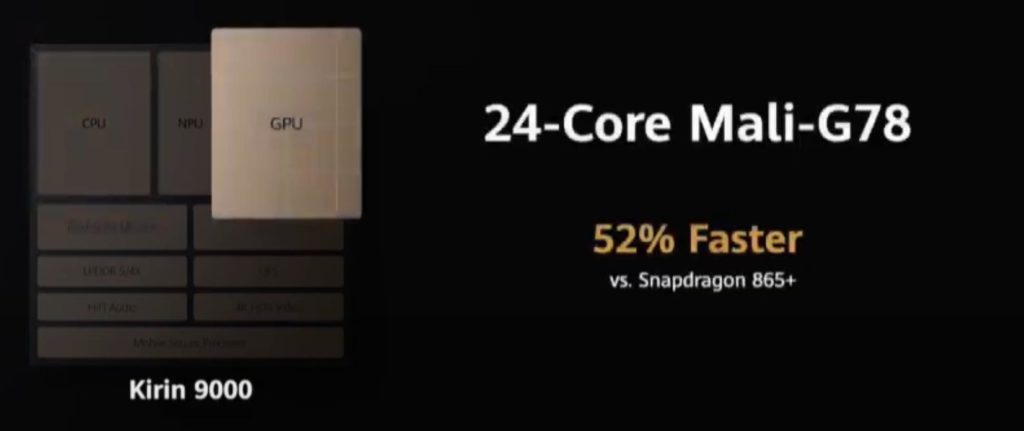

Benchmarks
Antutu
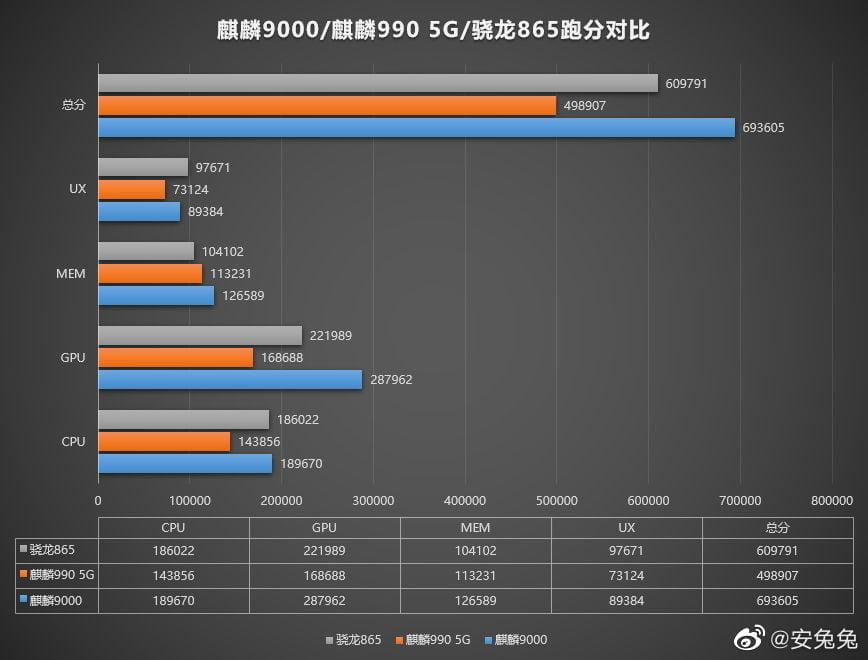
Leaked benchmarks indicate the Kirin 9000 achieving 693,605 which would put it almost 8% ahead of the currently most powerful phone on the market, the Asus ROG Phone 3 which uses the Qualcomm Snapdragon 865+.
It was previously reported than the Exynos 1080 would be able to achieve an extremely impressive result of over 650,000. While this is below the Kirin 9000, it is worth remembering this is not a flagship chipset.
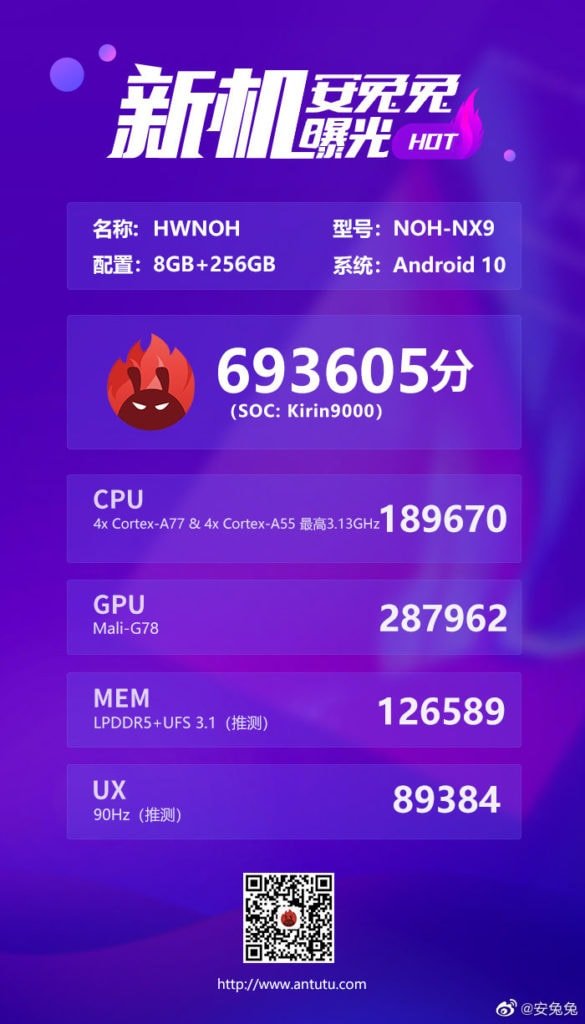
Geekbench
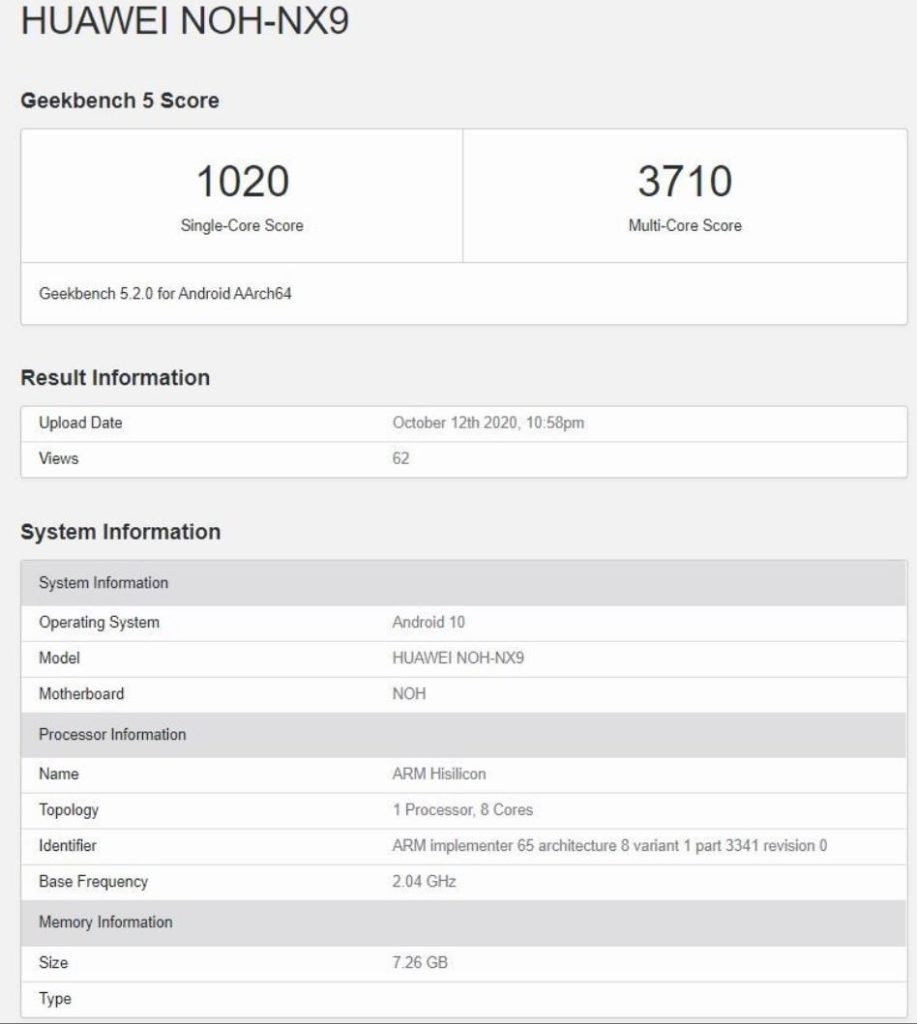
In Geekbench the Kirin 9000 managed to achieve 1016 for the single-core and 3688 for multi-core.
This puts it out comfortably ahead of the Qualcomm Snapdragon 865 which managed 975 and 3357, giving it a 4.2% and 9.8% advantage overall.
| Geekbench 5 | Chipset | Single Core | Multi Core |
|---|---|---|---|
| Honor Magic5 Pro | Snapdragon 8 Gen 2 | 1481 | 4932 |
| Honor Magic4 Pro | Snapdragon 8 Gen 1 | 1220 | 3569 |
| Xiaomi Mi 11 | Snapdragon 888 | 1139 | 3693 |
| OnePlus 9 Pro | Snapdragon 888 | 1109 | 3487 |
| Samsung Galaxy S21 Ultra | Exynos 2100 | 1079 | 3381 |
| Google Pixel 6 | Google Tensor | 1042 | 2957 |
| Xiaomi | Dimensity 8200-Ultra | 1005 | 3744 |
| OPPO Find X5 Pro | Snapdragon 8 Gen 1 | 976 | 3484 |
| Asus ROG Phone 3 S | Snapdragon 865+ | 975 | 3357 |
| Realme GT Neo 3 | Dimensity 8100 | 966 | 3672 |
| OPPO Find X3 Pro | Snapdragon 888 | 928 | 3357 |
| Realme X50 Pro | Snapdragon 865 | 910 | 3205 |
| Infinix Note 30 VIP | Dimensity 8050 | 854 | 3047 |
| Redmi K30 Ultra | Dimensity 1000+ | 782 | 2890 |
| Samsung Galaxy S20 | Exynos 990 | 772 | 2590 |
3DMark Benchmark
| Chipset | Sling Shot Extreme OpenGL | Sling Shot Extreme Vulcan | Wild Life | |
|---|---|---|---|---|
| OnePlus 9 Pro | Snapdragon 888 | Maxed Out | Maxed Out | 5775 |
| Samsung Galaxy S21 Ultra | Exynos 2100 | 7736 | 6467 | 5741 |
| Xiaomi Mi 11 | Snapdragon 888 | 8274 | 8182 | 5663 |
| Huawei Mate 40 Pro | Kirin 9000 | 9168 | 8401 | 5976 |
| Asus ROG Phone 3 | Snapdragon 865+ | 7645 | 7002 | 4127 |
| Realme X50 Pro | Snapdragon 865 | 3791 | ||
| Black Shark 3 | Snapdragon 865 | 7215 | 6606 | |
| Redmi K30 Ultra | Dimensity 1000+ | 6614 | 6143 | |
| OnePlus 7T | Snapdragon 855+ | 6278 | 5504 | |
| Black Shark | Snapdragon 855 | 5791 | 5030 |
In 3DMark we see where HiSilicon have focussed their efforts, the 24-core Mali G78 GPU decimates the competition.
In the Sling Shot Extreme OpenGL test the Mate 40 Pro scores 20% higher than the Qualcomm Snapdragon 865+ on the Asus ROG Phone 3 and 38% higher than the Redmi K30 Ultra using MediaTek’s top of the range chipset.
As far as generational improvements go, the Kirin 9000 offers more than double the performance than the Kirin 990 on the Huawei P40 Pro with a 106% difference.
Things are just as impressive with the Sling Shot Extreme Vulcan test being 20% ahead of the SD865+, 37% ahead of the Dimensity 1000+, and ever so slightly under double the performance of the previous generation Kirin 990 5G (98.4%)
What else is known about the Huawei Mate 40 Pro?
My original post was based on the many leaks about the phone, but a quick recap:
- Display: 6.76 inches AMOLED 90Hz 2772 x 1344
- Chipset: Kirin 9000 5G (5 nm)
- RAM: 8GB / 12GB
- Storage: 256GB / 512GB
- Rear Camera:
- 50 MP, f/1.9, 23mm (wide), 1/1.28″, 1.22µm, omnidirectional PDAF, OIS
- 12 MP, f/3.4, 125mm (periscope telephoto), PDAF, OIS, 5x optical zoom
- 20 MP, f/1.8, 18mm (ultrawide), PDAF
- TOF 3D, (depth)
- Front Camera:
- 13 MP, f/2.4, (wide)
- TOF 3D, (depth/biometrics sensor)
- Battery: 4400mAh with 66W charging and 50W wireless
- Other Features:
- Stereo speakers
- IP68
Overall
For the time being, the HiSilicon Kirin 9000 takes the performance crown comfortably outperforming the older Qualcomm Snapdragon 865 Plus.
During the launch, Huawei was a little cheeky with their marketing speak stating that other companies haven’t been able to launch 5nm yet. This is technically true, but Samsung have announced the 5nm Exynos 1080 and Apple are the first company to launch a 5nm chipset with the Apple A14. Qualcomm with their later launch cycle will announce the 5nm SD875 in December.
Mediatek remains a mystery, last year they were the first to announce a flagship, but it took months to materialise in a phone, there is no word on its successor yet.
With HiSilicon still using CPU architecture a year behind the up and coming 2021 flagship chipsets, the advantages the Kirin 9000 has will be short-lived when the SD875 becomes official. While the Qualcomm chipset will definitely beat HiSilicon with CPU performance it will be interesting if anyone can match the GPU performance.
For me at least, performance has become so good in mid-range and flagship chipsets that I struggle to notice real-world differences between one brand and the next. The Huawei P40 Pro performs just as well as my Realme X50 Pro. Things like battery performance have become more important to me nowadays.
It is sad that this may be the last flagship chipset from HiSilicon for a while, as much as I love Qualcomm chipsets, with them having such a dominant market share it will inevitably stifle future advancements.
I am James, a UK-based tech enthusiast and the Editor and Owner of Mighty Gadget, which I’ve proudly run since 2007. Passionate about all things technology, my expertise spans from computers and networking to mobile, wearables, and smart home devices.
As a fitness fanatic who loves running and cycling, I also have a keen interest in fitness-related technology, and I take every opportunity to cover this niche on my blog. My diverse interests allow me to bring a unique perspective to tech blogging, merging lifestyle, fitness, and the latest tech trends.
In my academic pursuits, I earned a BSc in Information Systems Design from UCLAN, before advancing my learning with a Master’s Degree in Computing. This advanced study also included Cisco CCNA accreditation, further demonstrating my commitment to understanding and staying ahead of the technology curve.
I’m proud to share that Vuelio has consistently ranked Mighty Gadget as one of the top technology blogs in the UK. With my dedication to technology and drive to share my insights, I aim to continue providing my readers with engaging and informative content.


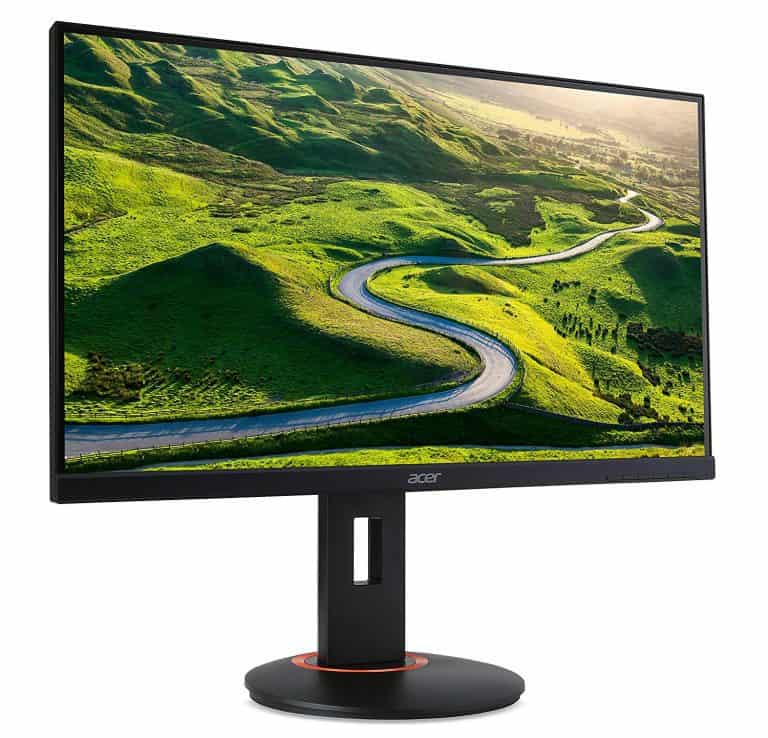
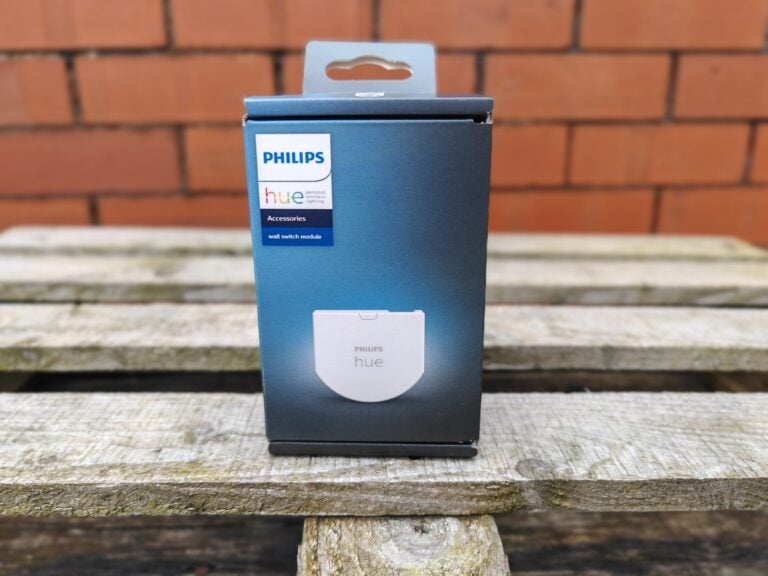
![Eufy Battery Powered Video Doorbell 2K Review – Is this good enough to replace my Ring Doorbell 3 Plus? [Currently 20% off at £143.99]](https://mightygadget.com/wp-content/uploads/2020/11/Eufy-Doorbell-Review-768x475.jpg)


